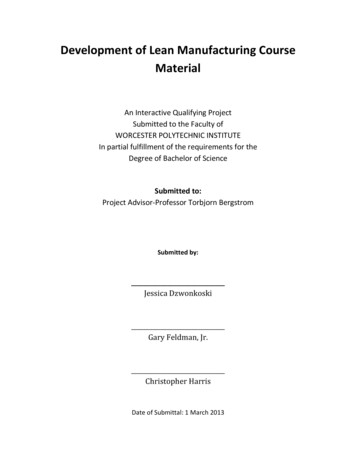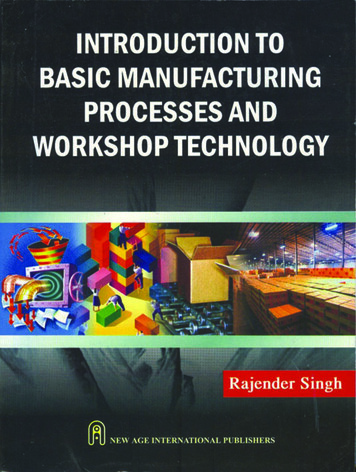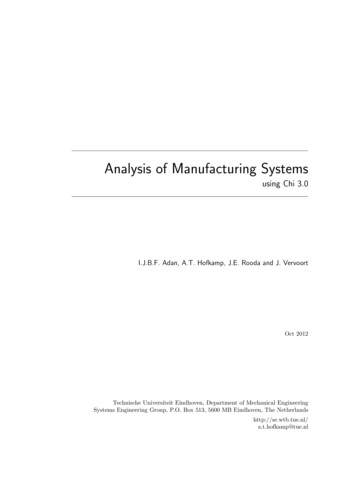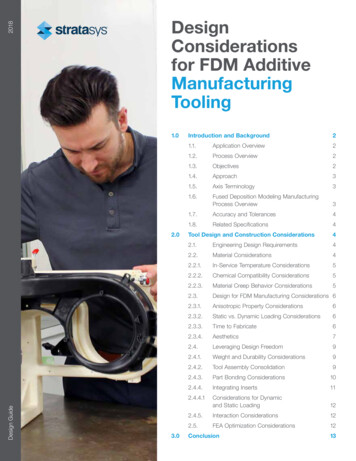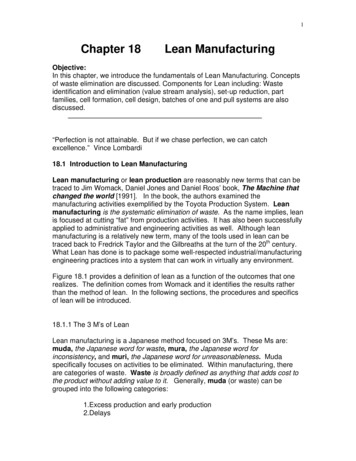
Transcription
GUIDE TOGOOD MANUFACTURING PRACTICE (GMP)REQUIREMENTS FOR CINNAMON PROCESSORS
'
Guide to Good Manufacturing Practice (GMP)Requirements for Cinnamon ProcessorsAuthorDr. Eresha Mendis (Ph.D.)Food safety consultant for UNIDOSenior lecturerDepartment of Food Science and TechnologyFaculty of AgricultureUniversity of Peradeniya
Year of Publication - 2016This Book was published by theUnited Nations Industrial Development Organization (UNIDO)jointly with The Spice Council (TSC) of Sri Lanka and Fundedby Standards and Trade Development Facility (STDF)ISBN 978-955-3959-01-0
Guide to Good Manufacturing Practice (GMP)Requirements for Cinnamon ProcessorsContentsPageThe scope of this booklet05The importance of food safety in the local and international food trade06The role of food safety standards and certification in ensuring food safety08GMP standard as a foundation for food safety management10The relevance of GMP standard for the Sri Lankan cinnamon industry10The good manufacturing practices (GMP) required to be established incinnamon processing to ensure compliance to the standard(1) Establishment: Design and facilities(A) Location12(B) Building and cinnamon handling areas13(C) Equipment and utensils14(D) Facilities15(2) Hygienic processing requirements(A) Raw material requirements19(B) Prevention of cross contamination20(C) Supervision of processing21(D) Packaging21(E) Storage of processed cinnamon (end product)22(F) Transport of the end product22(G) Sampling and laboratory control procedures23(H) Documentation and records23(3) Establishment of hygiene requirements(A) Maintenance24(B) Hygiene control program24(C) By-products25(D) Storage and disposal of waste2503
Guide to Good Manufacturing Practice (GMP)Requirements for Cinnamon Processors(E) Exclusion of domestic animals26(F) Pest control26(4) Personal hygiene and health requirements(A) Medical examination of communicable diseases and injuries27(B) Personal behavior28(C) Visitors29(5) Product information and documentation(A) Product information and recall procedures30(B) Lot identification and labeling30(C) Documentation and records31(6) Training31(7) Primary production32How to use the SLSI GMP standard to ensure conformity to GMPrequirements in a cinnamon processing unit and obtain GMP certification33Future directions3504
Guide to Good Manufacturing Practice (GMP)Requirements for Cinnamon ProcessorsThe scope of this bookletThe Sri Lankan food industry is growing and the number of food manufacturersinvolved in food processing has increased over the years. Parallel to this expansionin the sector, a higher attention is paid by the regulatory authorities to enforce foodsafety aiming to promote local and global food trade. In this context, food hygienepractice in food establishments has made mandatory from the year 2012 and allemployees who process, transport, distribute, handle, store or sale of food areexpected to be aware of the principles of food hygiene to lay the foundation for foodsafety in food establishments. These hygiene requirements are also common tospice processing industry. Being the main producer of cinnamon to the world, agreater emphasis is needed to be paid to establish them in cinnamon industry, forSri Lanka to remain as the main competitor in the world market. This bookletprovides guidance on practical aspects of developing, implementing, andmaintaining good manufacturing practices (GMP) within a cinnamon processingfacility to protect cinnamon from chemical, microbiological and physicalcontaminations. Requirements highlighted in this booklet can be followed by theinterested parties involved in cinnamon processing to obtain compliance to GMP.Development of this booklet was funded by United Nations Industrial DevelopmentOrganization (UNIDO) and Standards and Trade Development Facility (STDF) underthe “UNIDO-WTO-TSC” cinnamon project. This Project is managed by The SpiceCouncil ( TSC) of Sri Lanka.05
Guide to Good Manufacturing Practice (GMP)Requirements for Cinnamon ProcessorsThe importance of food safety in the local and international food tradeSafe food describes a food, which is free from hazards and thus such food will notcause any harm or injury to the consumer when it is eaten flowing the giveninstructions. Hazards are biological, chemical or physical in nature and, are harmfulagents that can contaminate food at any point of the food chain leading tofoodborne illnesses.In the food trade, safety of food is identified at domestic, regional and internationallevels as a public health priority, as unsafe food causes illness in millions of peopleevery year and result in many deaths all over the world. According to the WorldHealth Organization, serious outbreaks of foodborne disease have been reported inevery continent in the past decade and, in many countries the rates of relatedillnesses are increasing significantly. There are many reasons that food pose threatto human life and, the key global food safety concerns include spreading ofmicrobiological hazards, presence of chemical food contaminants, and hazardsresulting from new food technologies (such as genetically modified food) and thus agreat emphasis is placed on strong food safety systems in most countries to ensuresafety in local and global food chains.According to the reports of public health authorities, industrialized countries havebeen facing with an increasing number of food safety problems in the past twodecades and illnesses due to contaminated food are perhaps the most widespreadhealth problem in the contemporary world and an important cause of reducedeconomic productivity. The situation is equally or more serious in developingcountries, where infant diarrhea causes many illnesses and deaths. In addition toknown foodborne diseases, public health communities are being challenged by theemergence of new or newly recognized types of foodborne illnesses, often withserious and chronic health consequences. Certain populations (Eg. pregnantwomen, the elderly, infants and children, immunocompromised persons, and theunder- nourished) are particularly more vulnerable to food safety issues. Ineconomic terms, foodborne illnesses are very costly for the industry, healthservices, and society as a whole and, many factors contribute to the increase infoodborne diseases globally. Industrialization, leading to increased wealth andurbanization, has revolutionized the food supply system, resulting in mass06
Guide to Good Manufacturing Practice (GMP)Requirements for Cinnamon Processorsproduction and an explosive increase in the number of food service establishmentsand food outlets. Mass production, environmental factors, and inadequateknowledge of the food handlers have contributed to increased contamination ofprimary foodstuffs.The multinational approach to food production and distribution and theprogressive opening up of world markets have allowed the international food tradeto flourish. The globalization of food (and feed) trade, facilitated by theliberalization of world trade, while offering many benefits and opportunities, alsopresents new food safety risks. Because, infectious agents can be disseminatedfrom the original point of processing and packaging to locations thousands of milesaway. The globalization of foodborne diseases also results from increased travel. Aperson can be exposed to a foodborne illness in one country and expose others tothe infection in a location thousands of miles from the original source of theinfection.Food safety in the present context represents a transnational challenge requiringenhanced levels of international cooperation in setting standards and regulationsand in strengthening surveillance systems. Simultaneously, consumers arebecoming increasingly concerned over food quality and safety requirements. Suchconcerns have now been articulated via higher quality and safety standardsrequired by markets, with producers under greater pressure to meet suchstandards in their efforts to build consumers' confidence. However, theresponsibility of assuring food safety is a shared responsibility among all thestakeholder groups of the food chain. Everyone, including farmers and growers,manufacturers and processors, food handlers, consumers and the governmentshave a responsibility to assure that food is safe and suitable for consumption.07
Guide to Good Manufacturing Practice (GMP)Requirements for Cinnamon ProcessorsThe role of food safety standards and certification in ensuring food safetyFood safety management is a scientific discipline describing ways and means thatprevent foodborne illnesses. This includes a number of routines that should befollowed to avoid potentially severe health hazards. When supply chains becomingincreasingly globalized and complex, the need for standardized, internationallyaccepted food safety requirements become necessities for the food industry. Inresponse to this need, many food safety management systems (FSMS) arebecoming globally recognized as means to ensure food safety in a standardizedmanner. The food safety management system provides a preventative approach toidentify, prevent and reduce food-borne hazards. This is a means to minimize therisk of food poisoning and to make food safe for consumption. A well designedFSMS with appropriate control measures helps food establishments to comply withfood hygiene regulations and, ensure that food prepared for sale is hygienic andsafe for the consumers.Food safety standards that are developed based on FSMS sets out specific foodhandling controls related to the receipt, storage, processing, display, packaging,transportation, disposal and recall of food. Also other requirements relate to theskills and knowledge of food handlers and their supervisors, the health and hygieneof food handlers, and the cleaning, sanitizing and maintenance of the foodpremises and equipment within the premises. If complied with these requirementsit will ensure that food does not become unsafe or unsuitable. Some of theexamples for FSMS standards include GMP, hazard analysis and critical controlpoints (HACCP), ISO 22000 and food safety system certification (FSSC) 22000. GMPstandard provides the most basic requirements to ensure food safety throughcontrol of hygiene in the food establishment. A greater preventative approach istaken in HACCP. HACCP is a food safety management system, in which food safety isaddressed through the analysis and control of biological, chemical, and physicalhazards starting from raw material until the finished product reaches the consumer.In addition, HACCP can stand alone as a management tool in food business. It canalso be successfully integrated with other management systems and most of theother food safety standards including ISO 22000 are developed based on HACCPprinciples. Therefore, HACCP supports the implementation of other similar foodsafety standards and shares common requirements for controlling food safety risks.08
Guide to Good Manufacturing Practice (GMP)Requirements for Cinnamon ProcessorsFood safety standard certification is becoming a common requirement for doingbusiness throughout the food supply chain to confirm compliance. Some of thebenefits of a fully certified FSMS include the consistency in product manufactureand compliance to the buyers' requirements. Due diligence is one other importantaspect, because a FSMS can demonstrate that management is meeting itsresponsibilities in relation to food safety legislation and regulation and is doingeffectively. These standards provide systematic approach to processes and ensureemployees and other stakeholders are involved in the best practices and are awareof food safety concerns as they are well documented and function as day to dayactivities. Further, well-functioning FSMS will deliver long-term cost efficiencies byhelping businesses to diminish their risk of contamination and waster, throughcostly food recalls. Food safety certification conveys to consumers and themarketplace, as well as to employees and key stakeholders, that a food sectorbusiness has successfully met the requirements of a national or internationallyrecognized best practice approach.Planned audits conducted internally or by third party certification bodies providemeans in maintaining food safety standards and certification, by providingtransparency and assurance that requirements are maintained over the time. Thistransparency increases the collaborative capacity of stakeholders across the supplychain, and enhances safety, efficiency and continual improvement within individualorganizations.09
Guide to Good Manufacturing Practice (GMP)Requirements for Cinnamon ProcessorsGMP standard as a foundation for food safety managementIt is possible to control many of the potential hazards in a processing plant by using astandard set of principles and hygienic practices for the manufacturing andhandling of food to manage food safety. These standard principles and practicesare called good manufacturing practices (GMPs). They are sanitary and processingrequirements applicable to all food processing establishments. Goodmanufacturing practices provide a set of regulations, codes and guidelines thatcontrol the operational conditions within the food establishment allowing a safefood production. These requirements cover design and facilities of theestablishment, hygienic processing, establishment of hygiene in the premises,personnel hygiene and health of employees, transportation, product informationand documentation and food safety training. Basic concepts of these guidelinesremain to the ultimate goals of safeguarding the health of the consumers as well asproducing good quality products; those are safe and suitable for humanconsumption. The GMP is also a part of quality assurance which ensures that theproducts are consistently produced and controlled according to the qualitystandards appropriate to their intended use and as required by the consumers /orproduct specification. Most importantly GMP constitutes a prerequisite for theimplementation of HACCP food safety management system.The relevance of GMP standard for the Sri Lankan cinnamon industryAmongst the other agricultural exports from Sri Lanka, spices and allied productshold a greater share of the export revenue. According to information published bythe Export Development Board, Sri Lanka has captured the interest of the world,specially the interest of western nations due to the supply of spices with adistinctive quality. Cinnamon, pepper, cloves, cardamoms, nutmeg, mace andvanilla have been popular in the international market and the demand seems toincrease over the time. Among spices, cinnamon is the number one in the spicesector and currently Sri Lanka witness the pride of becoming the largest worldproducer and the exporter.10
Guide to Good Manufacturing Practice (GMP)Requirements for Cinnamon ProcessorsCinnamon is a crop which has a higher potential to develop considering itsadaptability to various soil and climatic conditions prevailing in Sri Lanka other thanits increasing export potential. Cinnamon has grown in Sri Lanka for many years andat present, pure Ceylon cinnamon is marketed as a branded product to the world.Cinnamon is used by the buyers for several purposes. In terms of food uses it ismostly used as a spice or a flavor enhancer. However, it is becoming popular as abeverage in many countries. The functional and medicinal effects of cinnamonpromote its use among the health conscious consumers. According to the marketdata it is becoming apparent that Ceylon cinnamon is losing few markets due to thepoor quality substitute cassava. Further the loss of market is resulted due to Ceyloncinnamon does not adequately meet product specifications and compliance to foodsafety and quality standards. Being a food, the quality and the safety criteria ofcinnamon need to be considered as vital parameters to be met in the cinnamontrade. Specially, when dealing with the exports, if the required quality and the safetyare not ensured in products, it is not possible to anticipate long termcompetitiveness to acquire a good market and a good export potential forcinnamon. Because many stringent regulations, standards and specificationsrelated to food quality and safety are appearing in the international trade due tosafety related issues of food items experienced by the consumers. The complianceto the requirements is a requisite to exist in the international trade seeking a betterfuture.Both cinnamon cultivation as well as processing take place mostly under smallerscale, The high cost of production, low volumes, and poor quality and absence offood safety standards have lead the industry to lose the competitiveness in majorexport markets. Considering the scale of production and other limiting factors ofthe cinnamon processing industry in SL, it is ideal to establish basic food safetystandards like GMP to lay the foundation for food safety demanded by theinternational market. GMP covers the basic conditions and activities that need toestablished in cinnamon processing to maintain a hygienic environment suitable forthe production, handling and provision of safe end product and safe food for humanconsumption. Understanding the nature of the operations and the risks associatedwith production and processing, the organizational GMP program needs to beestablished, implemented and maintained in such a way, the likelihood ofintroducing food safety hazards to the product through the work environment isminimized to maintain the high quality standards of products to customers.11
Guide to Good Manufacturing Practice (GMP)Requirements for Cinnamon ProcessorsThe good manufacturing practices (GMP)required to be established in cinnamon processing toensure compliance to the standard1.Establishment: Design and facilities(A) LocationEnvironmentally polluted areas and industrial activities pose aserious threat of contaminating food. Therefore, potential sources ofcontamination need to be considered when deciding where to locatefood establishments, as well as the effectiveness of any reasonablemeasures that might be taken to protect food.lllllThe location of the cinnamon processing center should be free from dust,smoke and odors. It is recommended not to place the establishment in areaswhere wastes, either solid or liquid, cannot be removed effectively.The surrounding should not be subjected to flooding. Logging of water harborpests and diseases and they get access to the processing area through manypaths.There should be adequate drainage to prevent flooding and provision shouldbe made for cleaning the drainage lines. Construct drains in a way to preventgas back-flow and equip them with traps and drain covers.Hard paved surfaces are recommended to roadways and areas used bywheeled traffic to prevent entry of dust and soil into the establishment.The boundaries of the processing site need to be clearly identified with afence and access to the site need to be controlled.12
Guide to Good Manufacturing Practice (GMP)Requirements for Cinnamon Processors(B) Building and cinnamon handling areasWhere appropriate, the internal design and layout of foodestablishments should permit good food hygiene practices,including protection against cross-contamination between andduring food handling operations.lllllllThe structures of the buildings and cinnamon handling areas should besoundly built of durable materials and be easy to maintain, clean and whereappropriate, able to be disinfected.The processing area need to be separated and partitioned adequately inorder to avoid cross contamination among different processing steps. (Eg.Raw material processing need to be separated from work-in progress orfinished products.)For a specific processing step, adequate working space need to be allocatedto ensure process is functioning hygienically and effectively.Prevent entering of pests and other contaminants. No direct openings in theprocessing areas to living areas, toilets, and raw material or waste collectingareas.Doors must be effectively protected with air curtains or by other effectivemeans. Outside opening doors shall be self-closing (fitted with door closures),tight fitting, and maintained in good repair.Ceilings must be constructed of smooth, non-porous, easily cleanablematerial and free of crevices.Walls of processing and storage areas should be smooth without cracks, holesand crevices that would inhibit cleaning or provide harborage for soil or pestsand should be made out with washable material. Walls need to be free ofinsects, dust, cobwebs, flaking paint and should be light colored in order tosee the presence of possible contaminants.13
Guide to Good Manufacturing Practice (GMP)Requirements for Cinnamon ProcessorslllllllCeiling surfaces as well as other overhead equipment such as, ventilationunits, light fixtures, and electrical piping must be clean, in good repair, free offlaking paint, dust, rust, holes, unsealed openings, or other conditions thatcould result in product contamination.There must be no evidence of water leaks on the ceilings.In cinnamon processing, indoor hanging lines just below the roof are used todry quills to ensure adequate drying. Therefore, it is essential to ensure thatthe roof does not act as a source of contamination through flaking, waterleaking or accumulating any other contaminant.Close windows when outside conditions exist that may expose the plant toairborne contamination. All windows or similar openings must be free ofdamage, tight fitting and properly insect screened.Construct floors that are smooth, non-slip tiles without crevices and should beeasy to clean and disinfect.Maintain floors in a clean and dry condition. Floors should be sloped toensure no standing of water and facilitate easy cleaning.Ensure adequate provisions are in place to monitor and prevent againstentering of pests, accumulation of dirt, trash, and filth that may potentiallycontaminate food.(C) Equipment and utensilsEquipment and other arrangements in the food processingenvironment need to permit adequate cleaning and maintenance.lEquipment, utensils and other arrangements are designed to prevent hazardsand installation permits cleaning and supervision.14
Guide to Good Manufacturing Practice (GMP)Requirements for Cinnamon ProcessorsllllEquipment, utensils and structures placed in the processing environment areresistant to corrosion and withstand repeated cleaning. These equipmentshould not transfer any smell, taste or chemicals that can change theproperties of food.Working surfaces that come into direct contact with food should be in soundcondition, durable and easy to clean, maintain and disinfect. They should bemade of smooth, non-absorbent materials, and inert to the food, to thedetergents and disinfectants under normal operating conditions.It is not recommend the use of wooden food-contact surfaces, as they arepotential contaminants and are a good harborage for microbialcontamination. It is almost impossible to sanitize wooden equipment.Containers for waste, by-products and inedible substances, should bespecifically identifiable (labeled clearly), leak proof and, where appropriate,made of impervious material.(D) FacilitiesAppropriate facilities and procedures should be in place to ensurethat any necessary cleaning and maintenance is carried outeffectively, an appropriate degree of personal hygiene is maintainedand process is carried out effectively and hygienically without spacefor cross contamination.(i) Water supplylClean water free of any contamination should be available in buildings wherecinnamon is cleaned or processed. It is advisable to have portable water for15
Guide to Good Manufacturing Practice (GMP)Requirements for Cinnamon Processorslprocessing activities and if any other water source is used, water qualitytesting need to be carried out to ensure its suitability in terms of chemical andmicrobiological parameters. Records of water quality testing need to bemaintained.In cinnamon processing, many processors use water to soak the incomingcinnamon sticks placed in washing tanks. This is a processing step where thecontamination of cinnamon sticks can be taken place if the water quality is notright. To avoid such contaminations, washing tanks need to have smoothsurfaces without cracks and crevices in the interior walls which ensureprevention of accumulation of dirt, algae and bacteria. Washing tanks need tobe routinely cleaned and managed. And frequent removal of water from thetank need to be practiced.(ii) Employees' personal facilitiesllllSuitably located adequate changing facilities, toilets and dining areasshould be provided and properly maintained.Ensure employee areas are well lit, clean, orderly, and effectively ventilated.Provide a designated storage area for employees' personal belongings (Eg.Lockers or cupboards). Signs should be posted informing employees of whatis permitted or banned within their locker. Periodic locker inspectionsshould be in force for hygiene purposes.Protective clothing need to be placed in cleaned environments and lockerscan be provided for this purpose. These lockers can be placed in the areaswhere the employees used to enter into the processing line. Lockers shouldfacilitate the segregation of clean and used protective clothing.16
Guide to Good Manufacturing Practice (GMP)Requirements for Cinnamon ProcessorsllConstruct toilet doors to be self-closing and not directly opening intoprocessing areas to avoid possible airborne contaminations. Hygienic handwashing, sanitizing and drying facilities should be provided adjacent totoilets. Post signs instructing employees to use toilets hygienically andspecially to remove protective clothing before entering the toilets.Post signs in locker rooms, toilet facilities, and at entrances to work areasinstructing employees about the proper hand washing and sanitizingprocedures.(iii) Hand washing and foot bathing facilities in processing areaslllAdequate and conveniently located facilities for hand washing should beprovided in the processing area where required.These should be facilitated with liquid, non-scented soap, hands-free tap (Ex.foot- or elbow-operated) where possible, single-use paper towels or otherdrying device and display boards as hand washing only (utensil washingshould be elsewhere).Foot bath is also need to be provided at all the entrance to the directprocessing areas to avoid contaminations coming through the entry ofworkers. The water of these foot baths need to be added with a suitabledisinfectant (sodium hypochlorite) and the water need to be frequentlychanged to ensure hygiene.17
Guide to Good Manufacturing Practice (GMP)Requirements for Cinnamon Processors(iv) Disinfection facilitiesllWhere appropriate adequate facilities for cleaning and disinfection ofworking areas and equipment should be provided. Allocated cleaningequipment, sanitizing agents, identified personnel and their responsibilities,and knowledge about basic hygienic practices are essential components toensure proper functioning of disinfection.Cleaning and disinfection equipment, sanitizing agents need to be separatelystored away from the processing area and if not it might lead to crosscontamination.(v) LightinglllAdequate natural or artificial lighting should be provided inside the building,particularly at processing areas and storage enabling to practice theoperations in a hygienic manner.The intensity should be changed according to the nature of the operationElectrical lights and fixtures should not be made out of glass, whereappropriate, be protected to ensure that cinnamon is not contaminated bypossible breakages.18
Guide to Good Manufacturing Practice (GMP)Requirements for Cinnamon Processors(vi) VentilationllllAdequate means of natural or mechanical ventilation should be provided, inparticular to minimize air-borne contaminations (aerosols and condensationdroplets) of finished products, equipment, and packaging materials. Alsoventilation becomes necessary to control ambient temperatures, andhumidity.Ventilation systems should be designed and constructed so that air does notflow from contaminated areas to clean areas and, where necessary, they canbe adequately maintained and cleaned.All ventilation systems such as louvers, exhaust fans must be cleanable andproperly functioning to serve the purpose.Wall-mounted ventilation fans should be screened so that there is no pestingress when fans are turned off.(2) Hygienic processing requirements(A) Raw material requirementsRaw material acceptance is the first step in the processing ofcinnamon. Therefore, the criteria used for accepting good qualitycinnamon sticks become very vital to ensure food safety in finishedproducts.19
Guide to Good Manufacturing Practice (GMP)Requirements for Cinnamon ProcessorsllllCinnamon sticks should not be accepted if they are found to containcontaminants (Eg. fecal matter) that cannot be reduced to acceptable levelsby cleaning using water, to ensure that the sticks will not contaminate theprocessing area.Also inspection should cover the vehicle condition to identify if any type ofcontamination has been taken place during transportation.During the inspection and unloading procedure, systems should be in place toprevent entry of birds, insects and other pests to the facility.Cinnamon sticks can be transferred to the peeling section through a specifiedentry point constructed across the wall and cleanliness of this operation needto maintained and supervised.(B) Prevention of cross contaminationPathogens can be transferred to processed cinnamon, through rawmaterials, food handlers, contact surfaces or air. As importantpreventive measures to control cross contamination, it is requiredto physically segregate areas designated for processing andstorage, identify work responsibilities and restrict access to theprocessing facility.llllUnprocessed cinnamon stick
to human life and, the key global food safety concerns include spreading of microbiological hazards, presence of chemical food contaminants, and hazards resulting from new food technologies (such as genetically modified food) and thus a . Guide


